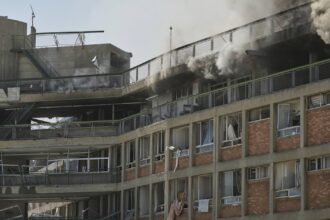Plumes of black smoke billow over Gaza City as the thunderous echoes of artillery fire punctuate an otherwise eerie silence. The grim reality on the ground marks yet another tragic chapter in a conflict that has now claimed over 34,500 Palestinian lives since October, according to the Gaza Health Ministry’s latest figures released Tuesday.
The death toll continues its relentless climb as Israeli forces push deeper into Rafah, the southernmost city in Gaza where nearly 1.5 million Palestinians had sought refuge from fighting elsewhere in the enclave. The Ministry of Health in Gaza reported that at least 34,535 Palestinians have been killed and 77,704 wounded in the Israeli offensive, with 32 fatalities recorded in the past 24 hours alone.
“What we’re witnessing is an unprecedented humanitarian catastrophe,” says Dr. Mahmoud Shalabi, a medical coordinator with Medical Aid for Palestinians. “Hospitals are operating far beyond capacity, often without electricity, clean water, or essential medical supplies. Many procedures are being performed without anesthesia.”
The crisis has intensified following the breakdown of ceasefire negotiations. International diplomatic efforts continue, but with diminishing returns as positions harden on both sides. The UN Office for the Coordination of Humanitarian Affairs estimates that over 90% of Gaza’s population has been displaced, many multiple times, creating conditions that humanitarian experts describe as “apocalyptic.”
Israel maintains its military campaign targets Hamas infrastructure and fighters responsible for the October 7 attacks that killed approximately 1,200 Israelis. The Israeli Defense Forces (IDF) spokesperson’s office stated yesterday that operations in Rafah have uncovered several tunnel networks and weapons caches, which they claim validates their tactical approach.
However, the civilian cost has prompted international outcry. The World Food Programme warns that famine conditions are imminent, with acute malnutrition rates among children under five reaching alarming levels. Clean water remains scarce, with most residents having access to less than two liters per day—far below humanitarian standards.
“The destruction of infrastructure has been systematic and comprehensive,” explains Professor Sarah Leah Whitson, former Middle East director at Human Rights Watch. “Rebuilding Gaza will take decades, not years, and that’s assuming the fighting stops tomorrow.”
Economic analysts from the World Bank estimate the reconstruction costs at upwards of $30 billion, a staggering figure for an area roughly the size of Detroit. Meanwhile, the psychological trauma inflicted on Gaza’s population—over 40% of whom are children—presents a less visible but equally devastating dimension of the crisis.
As diplomatic channels falter, regional tensions continue to escalate. Iran’s recent missile launch toward Israel and subsequent Israeli retaliatory strikes in Syria and Lebanon point to the conflict’s dangerous potential to expand beyond Gaza’s borders. Regional experts warn that without significant international intervention, the Middle East risks sliding into a broader conflagration.
The Gaza Health Ministry’s figures, while disputed by some Israeli officials as potentially inflated, have been generally accepted by the United Nations as credible. Independent verification remains challenging due to limited access for journalists and international observers.
As night falls over Gaza, the question that haunts the international community remains: in a conflict where lines between military and civilian targets have become increasingly blurred, how many more lives must be lost before diplomacy prevails over destruction?









